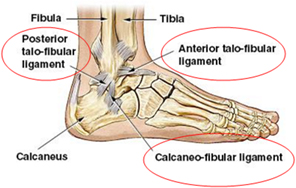An ankle sprain is an injury to the ligaments around the ankle after a traumatic event where the foot rolls onto its side at the ankle level. The ligaments will stretch or

Source: http://www.physicalhealthcare.com.au/wp-content/uploads/2012/04/Ankle-sprains_physiotherapy.png
tear. The level of stretching or the number of ligaments torn or partially torn determines the severity or grading of the ankle sprain. A sprain to the outside of your ankle is far more common than at the inside of your ankle. This is because the ligaments and muscles on the inside of your ankle are much stronger and so protect the inside of your ankle far better.
An ankle sprain is usually accompanied by swelling, bruising and pain of varying degrees depending on the severity of the injury. When the ankle is sprained, you will experience a rapid onset of significant pain directly related to the event.
While the pain associated with an ankle sprain may resolve with simple rest and icing; the strength, stability and often the range of motion of the ankle will be lost unless it is appropriately rehabilitated. A rehabilitation program should be developed and initiated as soon after the sprain occurs as symptoms allow. It is important to follow the direction of your podiatrist closely in order to regain your strength and stability and to prevent frequent recurrence.
Treatment:
Stage 1 – Symptom management:
– Rest the ankle completely. This may require you to have your ankle strapped and use crutches.
– Ice the ankle regularly for 5-10 minutes at a time.
– A compression sock may be helpful for reducing swelling
– Elevate your foot to heart level wherever possible
– Consider taking Ibuprofen on a short-term basis to help with pain and reduce inflammation.
Stage 2 – Early rehabilitation:
– This is aimed at improving the range of motion at your ankle which will have stiffened up after the injury
– Your podiatrist will recommend exercises appropriate to your individual case and level of rehabilitation such as writing the alphabet with your foot.
Stage 3 – Ongoing rehabilitation:
– This stage is aimed at regaining strength in the ankle
– Your podiatrist will recommend exercises based on your individual case, stage of rehabilitation and end goal of rehab (e.g. sport specific exercises)
Stage 4 – Late Rehabilitation:
– Once your range of motion and strength has been restored, you will move into the final stage of rehabilitation aimed at improving ankle stability to reduce the risk of reoccurrence. Recovering strength at the ankle will do this to some extent, however, there are some extra exercises to improve the final result of the rehabilitation program.
– Your podiatrist will demonstrate and recommend appropriate stability training exercises for you such as single leg tasks or tasks involving a wobble board.
Stage 5 – Return to sport preparation:
– Once your ankle is strong and stable enough to safely manage high impact activities, your podiatrist will introduce dynamic exercises that will be targeted towards getting you ready to return to sport and other normal activities.
– This may include exercises such as single leg bounds, skipping, double leg leaps, change of direction drills, etc.

Comments are closed.